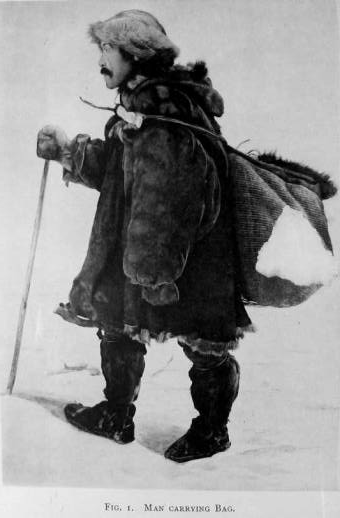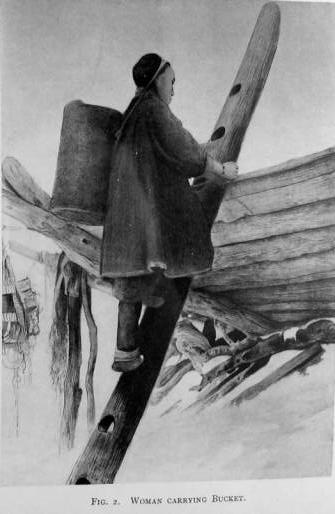на
главную
| |
|
Winter
Clothing of Men and Women |
587 |
| Summer
Clothing |
598
|
| Children's
Clothing |
601
|
| Coats
with Tails |
602 |
| Ornaments,
Hair-Dressing, and Tattooing |
603
|
| Snow-Goggles,
Snow-Shoes, Staffs, and Ice-Creepers |
604 |
| Yokes
and Carrying-Straps |
605
|
| Bags
for keeping Clothing |
607
|
| Belts |
607
|
IX.
CLOTHING.
Winter Clothing of Men and Women.
The winter clothing of both
branches
of the
Koryak is
made of reindeer-skins.
Skins of other animals are used only for
trimming or adorning winter
clothing. Only
fur caps and mittens
are not infrequently made entirely of dog, fox, or wolf skin, and the soles
of boots are
made of thong-seal or walrus hide.
Skins of grown rein- deer
are not
used for clothing, but only those of fawns, beginning with the newly
born and up to seven months old.
The warmest clothing is made of
skins
of fawns
six or
seven months
old, which
are killed late in autumn.
Their
fur consists of fine, soft,
not long, but very thick hair.
Clothing made
of
fawn-skins is not only
warm, but
is also
remarkably light
in weight.
Owing
to the lack of fawn-skins, the
Yukaghir and Tungus often make
their
|
winter overcoats of heavy winter skins
of
old reindeer. These are so heavy
that
they impede the motion of the
wearer.
Clothing made of the skins
of
mountain-sheep is equally heavy.
Winter Coat.
The fundamental
pattern
of the coat is the same
for
men
and women. It has the shape of
a
fur shirt which is pulled down over
the
head. The man's coat, especially
that
of the Reindeer Koryak who ride
astride
on their light sledges, is shorter
than
that of the woman (Fig. 115).
It
does not reach down to the knees ;
while
that of the women falls lower,
usually
down to the calves of the legs. The
winter travelling-coats of old men, especially
of the Maritime Koryak (Plate
XXXII, Fig. 1), reach sometimes
below
the knees. The cut of the coat
is
the same as that of
the Chukchee.
Fig. 115. Man's Coat. |
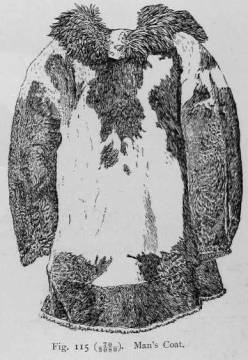
|
The sleeves are very full about the fore-arms to
enable the wearer to draw
his hands out and hide them within the shirt, and narrow about the wrists to prevent the easy access of cold air. The difference between the Koryak
coat
and that of the Chukchee is,
that between the lower border and the fur
[587]
588
JOCHELSON, THE KORYAK.
trimming
there is
inserted a
strip of reindeer-skin about four or five inches wide,
and of
a color
different from
that of the whole
coat. If the coat is
made
of dark
skins, the
inserted strip
is of light or
mottled color,
and vice versa.
The
Chukchee woman's
coat is
generally shorter
than that of the Koryak.
Under the
coat of
the Chukchee
woman the
lower part
of the trousers
is visible, but rarely under that of the Koryak woman. Among
the Chukchee,
coats are
seldom provided
with hoods, while among the Koryak all
the women's
coats and many of the men's
travelling-coats, are furnished with
hoods. Funeral clothing is never made without hoods.1
The women of the
Maritime Koryak
use almost no caps at
all, contenting themselves with throwing their hoods over their heads.
The women of the Reindeer
Koryak go
without caps,2 not only about the house,
but even to the herd.
The travelling-coat of men for winter (la'xlan-i'
san) is double, consisting
of
two fur shirts so adjusted that one is inside the other, and they are put
on
and taken off together. The inner shirt has the hair toward the body,
the
outer, outward. The two shirts are not sewed together, so that they are
easily
taken apart and can be worn separately. The outer one is made of
the
skins of fawns, preferably of those of mottled color killed late in the fall.
Black
or dark brown spots on a white or grayish background are considered
particularly
pretty, but the skins most commonly used have white or grayish
spots
on a dark or a light-tawny background. White or light-gray skins are
used
for funeral clothing only. 3 Russian settlers and Russianized natives prefer
black
or dark-tawny reindeer-skins. In certain localities this taste is devel-
oping
also among the Koryak. Thus the Koryak who are engaged in trade, and
rich reindeer-breeders, wear outer coats of dark skins. The inner coat is
usually made of skins of younger fawns, fromone to three months old, so
that
the double coat may not be too thick and hinder movement. Besides,
the
tender fur of young fawns is more pleasant to wear next to the body
than
the thicker hair of the older fawns. The Koryak wear fur clothing
next
to the body. Excepting those entirely Russianized, very few Koryak
wear
chintz or calico shirts under the fur clothing. These are worn without
change
until they fall to pieces.4
Women rarely wear a double winter coat, as they put the coat on over the
double fur combination-suit which will be described later on. For the most
part, women
wear the
single coat,
fur inward.
The skin side, well
1
See Part I, pp. 106, 108.
2
It
is interesting to
note here
Turner's statement
that the Eskimo of
Hudson Bay "do not wear caps, the
hood of the frocks being the only
head-covering" (see Turner, p. 209).
3
See
Part I, p.
105. According to Murdoch
(p. 109), the Eskimo of Point Barrow value the skins of the
white Siberian domestic reindeer highly "for full-dress jackets."
But the Koryak do not wear clothing of white skins.
4 Like
the Russian settlers, the Koryak of Russianized villages wear chintz shirts,
flannel blouses, or knit
jackets under their fur coats. I saw some Maritime Koryak wearing
American knit sweaters or coats purchased from
the American whalers. A very comical figure indeed was presented by a
Koryak clad in trousers and boots 01
remdeer-skins and a cutaway coat of modern stile, which he wore without shirt
and vest.
589
JOCHELSON,
THE KORYAK.
dressed,
is dyed a dark red or tawny hue, and adorned with pendants, stripes,
and square patches of white skin,
and with glass-bead embroideries.1
|
To
the breast of the outer coat with attached hood, and near the collar, a
fur flap made of the skin of reindeer-legs is sewed (see Fig. 116). This
flap
serves to protect the face from cold
winds. In the funeral coat this flap is
used for covering the face of the deceased.
At home, or when working near the
house,
the Koryak men, even in the cold
of
winter, ordinarily wear a single fur shirt with
the fur side either in or out. A coat
worn
with the flesh side next the body
has
the advantage that the hairless skin
does
not afford nesting-place for insects; but,
on the other hand, it is easily soaked
by
perspiration, and hardens when it dries
again.
The single coat is shorter than the
double
one, and has no hood. The neck is
wide enough to allow the head to pass
through
freely. It has a hem of skin,
through
which a nettle cord or leather strap
is
passed for tightening the collar. The
ends
of the cord are tied in front. To the necks
of most single shirts a collar of black
dog-fur
is sewed. These collars are of
varying
width. I saw particularly wide dog- fur
collars among the Reindeer Koryak of the
Taigonos Peninsula (see Plate xl, Fig.
1). The
fur of white dogs is used only for
trimming
funeral clothing. |
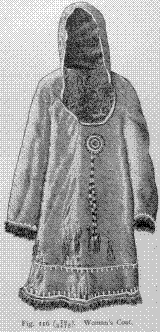
|
|
Fig. 116. Woman's Coat. |
Woman's
Winter Combination-Suit.
It
has been
stated before that women do not wear fur shirts next to the skin. Under the
shirt they wear a fur suit
similar
in cut to the modern combination underwear for women. Such fur
suits are worn in Siberia by the women of the Chukchee, Asiatic Eskimo,
and
Koryak, and, according to a statement of Nelson, by the Eskimo women
on
Diomede and St. Lawrence Islands.3 In former times all the Kamchadal
women
also wore such suits.4 The Koryak call this suit ๑a'u-kei ("woman's
combination") in contrast to the children's combination-suit called kei-kei.
The
1
On the adornment of clothing,
see Chapter XI.
2
See
Bogoras, The Chukchee, Vol. VII of this series, p. 244.
3
Nelson,
The Eskimo about Bering Strait, p. 30.
4 See Steller, I, p. 37;
Krasheninnikoff, II, p. 64.
590
JOCHELSON, THE
KORYAK.
women's suit consists of a broad bodice joined to
wide Turkish trousers which
are
gathered below the knees (Figs. 117, 118; and Plate XXXII, Fig. 2).
On the chest and back the bodice has a deep cut into which the woman
steps when putting on the suit. The sleeves are very wide, both at the
shoulders
and wrists, so that the hand can be taken out without any difficulty,
which
must be
done when
the woman
wants to
let down or take off the
|
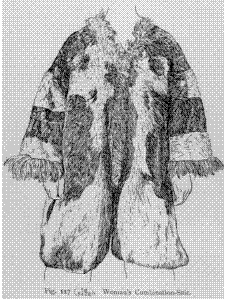
|
garment. A double combination-suit for women, for
use
in
winter, is made of fawnskins
similar to those used
in
the man's double winter
coat. A single, outer
combination-suit is shown in Fig.
118; and an inner combination-suit,
with hair side in,
is represented in Fig. 119.
Below the knees, where the
trousers of the combination-
suit are drawn in, the edges are
trimmed with a leather hem, through which a cord
runs for tightening the trous-
ers and for tying them over
the legs of the boots. The
combination-suit of the Koryak
woman is more carefully made,
and of lighter weight, than
that of the Chukchee woman, and thus does not
render movement
quite so |
|
Fig. 117. Woman's Combinations-Suit. |
|
difficult. The suit of the Chukchee woman represents a
huge skin sack with
four
appendages for the hands and feet. The ornamentation of the suit is
also
prettier than it is among the Chukchee. The lower portions of the sleeves
and trouser-legs are often sewed together of alternate white and dark vertical
stripes of fur from reindeer-legs. The lower parts of the sleevesoften
consist of black and white fur checks made of pieces of fur from rein-
deer-legs.
Women's funeral combination-suits are trimmed with particular
care,
and are very handsome (see Part I, Fig. 52,
p. 108). The Reindeer
Koryak
women, however, do not trim their clothing with equal care. Plate
XXXII, Fig. 2, represents a wealthy Reindeer Koryak woman from the Taigonos
Peninsula,
dressed in a combination-suit. She wears this suit over a chintz shirt, and not next to her
skin.
591
JOCHELSON,
THE KORYAK.
The slit of the bodice,
and the
borders of the sleeves, are trimmed with strips of dog or wolf skin or with
some other long-haired
fur (see Fig.117).
Old
women also
cover the
neck with
a boa
of squirrel-tails, which they
acquire
from the Tungus, or
with a woollen
scarf bought of the Russians
While
the Chuckchee women wear no upper garments when near the
ouse,
and when working near the fire or at the hearth bare the right arm or
the
entire bust to be free in their motions, the Koryak women are ashamed
of
being seen in the combination-suit
alone in the presence of strangers. Not
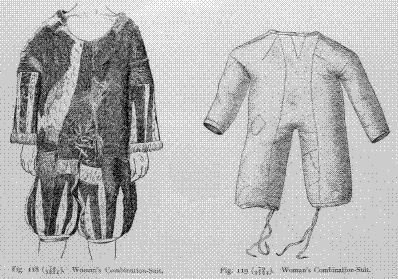
Fig.118.
Woman's Combination-Suit. Fig.119. Woman's Combination-Suit.
one woman of the Maritime Koryak consented to pose
in front of the camera
dressed in a combination-suit only. My wife succeeded in inducing a little orphan-girl
of eleven or twelve in the village of Kamenskoye to have her
photograph
taken without her coat; but suddenly she refused because her uncle
said that she ought not to do so. Among the Reindeer Koryak
also
the girls refused to be photographed without a coat, but the women did
not
present difficulties. Generally Reindeer Koryak women take their coats
off
in the inner tent only. On the Palpal, where the Koryak come in contact
with
the Chukchee, the women of the Reindeer Koryak, like the Chukchee women, wear nothing but the combination-suit near the
house. Krashenin-
nikoff1
says that
the Kamchadal
women of
his time
at home
wore the
1 See
Krasheninnikoff. II, p 64. At
present most of the Kamchadal dress just like the local Russian settlers.
75Jesup north pacific exped.,
vol. vi, part 2.
592
JOCHELSON,
THE KORYAK.
combination-suit only. Hence the question arises,
whether the modesty of
the
Koryak women in this regard is a result of the influence of the Russians, or whether it is due to the fact that the sexual relations of the Koryak differ
from those prevailing
among the Kamchadal and Chukchee, 1 and bring about
different standards of modesty.
When
feeling warm or while working, the Koryak women take the right
hand
out of the combination-dress and let the empty sleeve dangle down under
the upper
garment. At
home the
Koryak women
always wear the
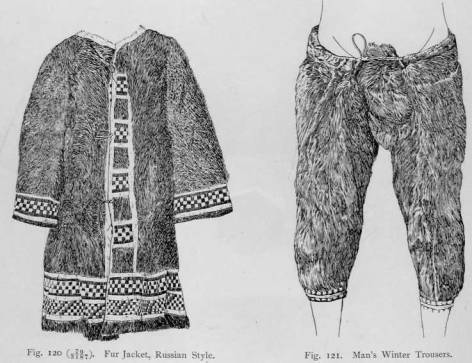
combination-dress that way. The end of the sleeve
is seen hanging down
under
the skirts of the coat. There are no other openings in the combina- tion-suit
save the one in the top of the bodice for getting into it, and those
at the insteps for the feet. To satisfy the demands of nature the Koryak
woman has to free her arms from the sleeves and drop the suit
down
to her feet. The Chukchee women do so openly, while the Koryak
women
perform this complex operation under the coat. First they take the
arms
out of the coat-sleeves, then they release the arms from the sleeves of
the
combination-suit and put
them back
into the coat-sleeves.
Then, when
1 See Chapter XII.
594
JOCHELSON, THE KORYAK.
long
legs, reaching up to the thighs, where they are tied or buttoned on to
short loin-breeches. Nelson says that the lower garments of the women of the Alaskan Eskimo are boots and trousers
combined,1 while Murdoch says
of the
Eskimo of Point Barrow that women's trousers are combined with
boots, and
that at times even men wear such
trousers.2
Winter Foot-Gear. Most
of the winter foot gear consists of fur boots
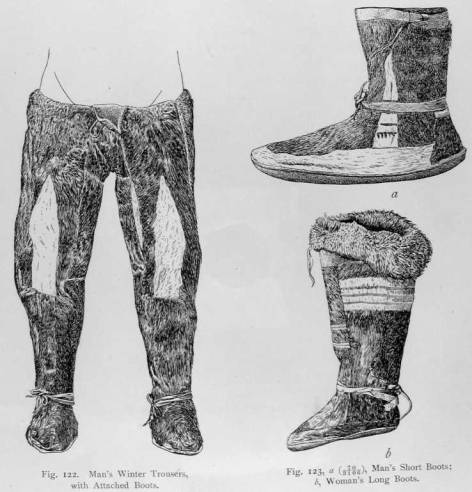
(pla'kit) and
stockings reaching up to the knees. The boots are usually made
of the skin of the reindeer-leg. Its fur is short, glossy, and of greater dura-
bility than the fur of other parts of the reindeer.
Men's boots are either short (Fig. 123, a) reaching a little above
the ankle, or they have legs extending up to the knee (see Plate XXXV, Fig.2).
Both styles have
1 Nelson, p. 30.
2 Murdoch, p. 126.
596
JOCHELSON, THE KORYAK.
hair
of which is cut short. Hence the legs of women appear very stout about
their
calves, between
the lower and upper strings
with which the boots are tied.
A woman's winter boot, with
fur stockings inside, the legs of the boot ornamented
with inserted parallel lines of
white fur, is shown in Fig. 123, b.
Stockings
are made of the skins of large fawns,
and are worn with the hair
side in. With the
boots, the stockings form a double foot-wear, just as two
fur shirts compose a double coat, and
are mostly put on and pulled off together.
For the
night, however,
stockings which have been
worn during the
day are taken out
of the
boots, turned inside out, and
hung over the hearth
or out
of doors to dry. The skin
for stockings is dressed soft, and
the
flesh side
is painted cinnamon-color.1
Stockings are made large, with a wide
semicircular toe, like the boots, into
which they fit snugly. The
cut of a
fur stocking
differs from
that of
a fur
boot in
that there
is no stripe inserted
between the sole and the vamp.
A small leather strap is sewed to
the
upper end of each stocking.
These are tied together when the stockings are
hung up to dry. Before
the stocking is put into the boot, dry grass, of which
a supply
is always
kept on
hand, is put in.
The grass lining adds to
the softness
of the
fur foot-wear,
and protects the foot
against injuries. The
grass lining must be changed often to keep it dry and soft.
When
traveling in very cold weather, or sleeping over night under the
open
sky, short hare-skin socks are often worn inside the stockings. I also had
occasion to see some of my Maritime Koryak drivers, when sleeping at
night
on the snow by the camp-fire, put on over their travelling-boots huge
galoches
made of the winter skins of reindeer. They would then put a long double
fur shirt over the short one, draw hands and head within the shirt,
and
lie down on the snow, head to the fire. These large boots are evidently
a
Russian invention lately adopted by the Koryak. In general, the Koryak
are
not particularly careful to protect themselves against the cold when sleeping out
of doors. Not infrequently herdsmen pass cold nights wearing only a
single
coat, with belt. The stockings for short boots of men are also short.
Winter Cap and Mittens. The winter cap (la'xlan pe'nken) is double, and
made of the fur of reindeer-fawns. The inner lining is the fur of a
new-born
fawn or of one a month old. The outer cap is often made of dog
or
wolf paws. In front and at the back it is trimmed with a strip of shaggy
dog
or wolf fur. Costly caps are trimmed with wolverene-fur all round. The
top
of the cap is rounded. It has the shape of an old woman's sweeping-
cap
(Fig. 124). In front the fur trimming protects the fore-head; at the back the
cap covers the occiput and neck. A rather long leather strap, the ends of
which are sewed to the lower edges of the cap, is twisted once under the
chin
(Fig. 124, a; and
Plate xxxii,
Fig. 1), and the end
loop is turned back
1 See Chapter. X.
597
JOCHELSON,
THE KORYAK.
over the crown of the head to hold the cap down.
When a Koryak feels too
warm,
he throws his cap back, and it dangles down from the loop which passes
around his neck. A warm cap like the one here described is worn
with
a hoodless coat. A cap with light trimming is worn with the coat with
a large fur hood. Herdsmen who have to run after the herd wear hoodless
coats
and light caps
They usually put on the
outer coat only for the night.
|
Women
very rarely wear caps, Maritime Koryak
women,
when going out of doors in winter, throw
the
hood of the coat over the head. Only the
Reindeer
Koryak women,
while wandering
from camp to camp, wear
cap under the hood. Its
shape does not
differ
from that of the
men's
cap. Women's
funeral
costumes have
no
caps, a fact
which
shows that in
former
times the Kor-
yak
women did not
wear
caps.
The
Koryak fur
cap
is prettier and more
neatly made than
the
Chukchee cap.
Besides
the pretty
trimmings,
it has in-
serted
in the crown,
and
at the place which
covers the occiput or-
naments made of alter-
|
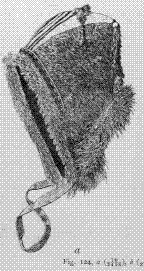
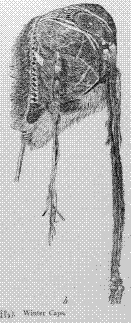
|
|
Fig. 124. Winter Caps. |
nate stripes of black and white skin from the legs
of reindeer-fawns, or
lozenge
patterns. Behind, long tassels of seal-pup skin, dyed red, are sewed
on;
and on the sides, circles are embroidered with glass beads of various
colors.
To the crown of the cap are often stitched two pieces of fur or
leather,
which project upwards like the ears of a fox. Some caps are not
rounded in shape at the crown, but have angular projections at the sides (Fig. 124, a).
The man's funeral cap has the shape of a round decorated
skull-cap
with ear-flaps stitched on, and an embroidered leather-strap1 with
which
to tie it under the chin.
1 See Part I, Fig. 48, p. 107.
598
JOCHELSON, THE KORYAK.
Men
who drive dog or reindeer teams, and who watch herds in winter, wear
mittens made of the skin of reindeer-legs.
The hair of the skin of the reindeer-leg
is short,
thick, and shiny.
It does not readily wear out
or fall off
from dampness.
Further, these
mittens are
light and
exceedingly soft when
well dressed,
so that they are not in the way when
holding the reins and
the whips, or doing any other work on the journey.
These mittens are not
very warm,
since they
are not usually made
of double skin, and have the
hair side
out. Sometimes
they are lined inside with fur of a new-born reindeer-fawn;
but young
people go
without the
inner mitten, and do
not suffer
from cold.
Light mittens are also made
of the skin from
dogs' legs. Women usually
wear warmer double mittens,
with shaggy trimming of dog, wolf, or
fox fur,
about the
wrist. The
outside mittens
are made
of the dressed
skins of
reindeer-fawns; the
inside mittens,
of the fur of new-born fawns.
Mittens made of the fur of wolf-paws on
the outside, and lined
with the
fur of young fawns, are regarded as warm and pretty.
Summer Clothing.
In general, summer clothing differs little from
winter
clothing. Real warm summer days are very few in number. In summer,
as well as late in spring and early in autumn, the old worn-out
winter
clothing is put on, only in single suits. At this season much of the hair
has fallen off. Therefore in summer the Koryak present a shabby and
unattractive
appearance. This is true particularly of the Reindeer Koryak, who
do not use special summer clothing while roaming with their herds in
the
mountainous regions, where it is colder than in the valleys; but the Koryak
who
live in the valleys and near the mouths of rivers, particularly those of
the
coast, have special summer clothing for
the warmer part of summer.
Summer coat.
The ordinary summer coat (ala'kin-isไn) is a shirt of
curried
and smoked reindeer-skin, and shirts of this kind are worn by both sexes. Those of women are longer than those of men, and more frequently
furnished
with hoods. Sometimes a dog-skin collar is attached. The cover
of
the upper part of the tent which has been exposed to the smoke for a
long
time is often used as material for such shirts. The skin, after being smoked, is
more
waterproof than unsmoked skin, and does not harden after rain.
Shirts of unsmoked leather, such as are worn
in winter over fur coats,1
sometimes ornamented by means of
wooden stamps (see Fig. 218),
are also
worn in summer; they are not used in
rainy weather, or for fishing and sea-
hunting, as dampness hardens them.
During
the sea-hunting season, especially in damp and cold weather, the
Maritime
Koryak wear dog-skin coats, with the hair side in (Fig. 125).
A dog-skin shirt is considered a good waterproof garment. Such a shirt rarely
has
a hood.
It is
worn mostly by lads in
their teens. At
home, even in
1 See p. 593.
Jesup
North Pacific Expedition, Vol. VI.
Plate XXXIII
|
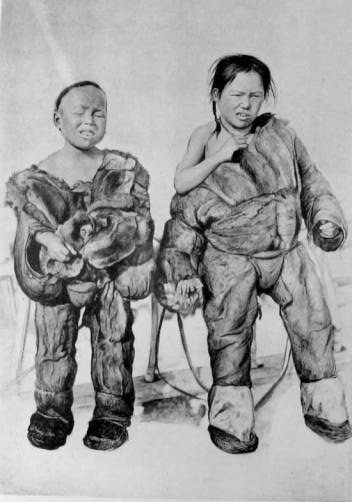
|
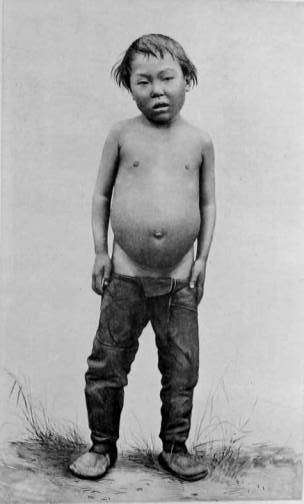
|
|
KORYAK CHILDREN |
The
Koryak.
599
JOCHELSON,
THE KORYAK.
winter, boys wear dog-skin coats (see the elder
boy on Plate XXXIII, Fig. 1).
Summer
clothing of dog-skin is always saturated with fish and seal oil, and is
dirty in the extreme.
I
have never seen a Koryak wearing a seal-skin coat, which is used by
the
Eskimo as a waterproof garment. I think that the absence of seal-skin coats
for summer wear is due to the insufficient quantity of seal-skins, which are
required in great numbers both for the household and for exchange.1
Likewise I
have never
seen any
clothing made
of bird-skins
and of seal-intestines,
which they say was worn
in olden times.
|
In
summer and autumn,
shirts
made of winter reindeer- skins
with shorn fur, and others
of
summer skins of grown rein-
deer
with short new fur, killed just
after the shedding of the
hair,
are also worn. Women
wear
coats made of such skins,
the
flesh side out. This side
is
well dressed, and dyed a
cinnamon
color, and adorned
with
strips of white leather,
tufts
of hair, circles embroidered
in
applique-work, and other
embellishments.
At home the
Maritime
Koryak women wear
such
coats even in winter. Dan-
cing-coats
(mi'lau-i'sใn) are made
up
in the same way, only
they
are more elaborately deco-rated than the ordinary garments.2 The
dancing-coats of men have no hoods.3
Fig.
125. Man's Dog-Skin Coat. |
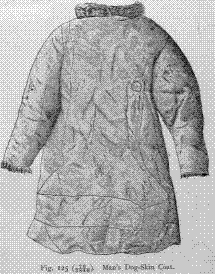 |
Summer Trousers and Combination-Suit.
In midsummer, men wear
trousers
of curried leather (Fig. 126), the pattern of which does not differ
from
that of the winter trousers; while women wear a combination-suit of
leather
under their coats. The leather of which both men's and women's
summer
trousers are made is either ordinary, soft-dressed, or curried and
smoked
reindeer-skin. The latter is used for waterproof clothing worn
during
the fishing-season.
Waterproof trousers
for men,
made of seal-skin,
1 According to Tale 21 (Fart I, p.
162), clothing made of seal-skins is regarded by the Koryak as that of
poor people. From this it may be inferred that seal-skin clothing was
used in olden times, when the reindeer was
not
domesticated.
2
See Part I, Fig. 27, p. 68.
3 Ibid., Plate I, Fig. I.
76
JESUP
NORTH PACIFIC EXPED.,
VOL. VI.
PART 2.
600
JOCHELSON, THE
KORYAK.
are rarely found. While engaged in sea-hunting,
the Maritime Koryak, espe-cially
lads, often wear dog-skin trousers. In autumn, and on cold days in midsummer,
the Koryak wear old, worn-out, single winter trousers of reindeer- skin
with the fur on.
Summer
Boots, Caps,
Mittens, and Gloves. Summer foot-wear con-sists
of boots or short shoes alone.
In summer, stockings are not
worn, and
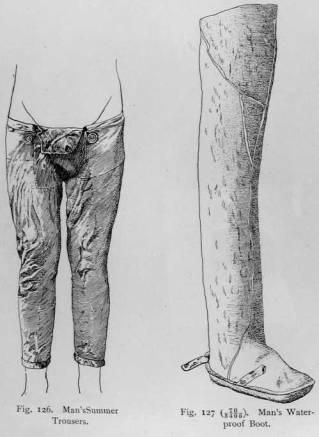
|
only grass linings are
used
in boots and shoes.
Summer
boots or shoes
are
made of the skin of the
legs of reindeer-fawns or dog-pups, of dressed skin
of the ringed-seal
and
of curried leather
made
of reindeer-skin.
Summer
and winter boots
and
shoes are the same
in
shape; but summer
foot-wear
is smaller than
that
for winter, because
it
is worn without the stocking.
The soles of
all
summer foot-wear are
made
of thong-seal skin
or
of walrus-skin split in two.
Short boots or shoes
are worn by men only. The
leather
straps
passing through the
lower hems of the trou-
ser-legs are drawn to- gether tight around the
upper end of
the legs
|
|
|
of these short boots. The legs of men's high boots, and
generally also those
of
women, reach up to the knees, and are drawn together with leather straps
over
the trousers. Waterproof boots are made of ringed-seal skin treated
with
blubber. Boots made of smoked reindeer-skin do not get wet as quickly
as
those made of unsmoked skin. Often only the vamps of the boots are made
of
seal-skin or of smoked leather; and the legs, of ordinary dressed reindeer-
skin.
Among the Maritime Koryak I found long-legged waterproof boots for
men
reaching up to the thighs (Fig. 127). The soles are made of thong-
seal
skin; the vamp and legs, of ringed-seal.
601
JOCHELSON,
THE KORYAK.
Women's
summer boots,
like men's
dancing-boots with
legs of curried leather,
are decorated
with pinked stripes of the thin soft
white skin of the dog's
neck, forming
the so-called "tooth-pattern."
Sometimes the toes up to the
instep are
made of the skin of ringed-seal dyed
black, while the instep and
legs are of reindeer-leather dyed a cinnamon
color. The
women of the Maritime
Koryak wear
such boots
also in
winter, when at home;
or they put
them on
after finishing their out-door work,
or while drying their winter boots
on returning home from a trip.
But such leather foot-wear, for change, is
made larger
than the
summer leather boots, so
that they can be put on over
the fur stockings.
I have said
before, that, even in winter, women
rarely wear a cap, but
cover
their heads with the hood which is attached to the coat. In summer
they
also go bare-headed, or in stormy weather they throw the hood of the
summer
coat over the head. Nowadays many women tie a kerchief on their
head
in summer, as is customary among Russian women (see Plate xxx, Fig. 2).
|
Men's
summer caps are made
either of fawn-skins or of the dressed skin of ringed-seal, with the hair on (Fig. 128). The
latter
material
is used chiefly
by the Maritime
Koryak .
Summer mittens are made of curried reindeer-skin, or
of the dressed skin of ringed-seal, or of spotted seal. During
the sea-hunting season the Maritime Koryak ear
mittens of dog-skin.
The Koryak very rarely wear gloves, which, to judge
by the pattern, have been adopted from the neighboring
Tungus tribes. The back and the palm of
each glove are cut from the same pattern. These parts
are placed one upon the other, and the edges,and
also the sides of the hand and fingers, stitched together
with sinew-thread. The thumb is cut sepa- rately,
and consists, like the rest of the glove, of two halves
of the same shape. It is inserted in an opening left
in the glove under the index-finger. |
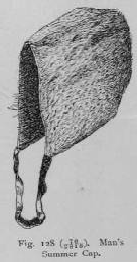
Fig. 128. Man's Cap. |
Children's
Clothing. Clothing for children
up
to the
age of five or six, and
sometimes that of children even a little older, consists, like the women's underwear, of a
com- bination-suit, called kei-kei or ma'l๑i-kei ("bifurcated kei"). The
children's combination-suit
differs from that of women in several respects. It often has a
hood sewed on. It has a long slit between the two halves of the trousers,
and
a fur flap (Koryak, mใka) stitched on at the back, over the slit. On the
inner side of this flap dry moss and powdered rotten wood are placed.
The
flap is passed up in front between the legs, and the two straps attached
to
its ends
are tied
around the
waist. The
child's excretions are absorbed
602
! на этой
странице
текст был
частично
поврежден.
JOCHELSON, THE KORYAK.
by
the moss and powder, and remain there until the mother unties the flap. The
soiled moss is thrown out, the babe's body is wiped with clean moss, and
the flap is tied up anew. In infants's suits, the sleeves and the legs are
sewed
up.1 Nurslings up to a year and over have two suits, one for the
daytime,
made of soft fawn-skins; and one for the night, made of thin skins
of
new-born fawns, or of curried leather. Older children sleep naked at night, like
adults, and hence have only suits for the day. Children's night-suits are
made
light to keep them from being too hot under the fur blanket. The
night-suit
is put on infants to
event soiling the bedding. This preventive
is
the more necessary, as the Koryak
have no cradles or cribs, and the
children
sleep with their motl
er one blanket made of reindeer-skins.
Children able to walk ru
out the house or the camp with the flap
untied,
and dangling down lik
tail. When it is time to break camp, these
children,
like nurslings, have their flaps tied up. When children begin to
walk,
slits are made at the wrist parts of their sleeves to enable them to
stick
their little hands out and take them in; and instead of closed trousers, boots
with separate stockings are given them. In the camps of the Reindeer
Koryak I had occasion
to see children seven or eight years old in children's combination-suits with the flaps hanging down
at the back. On Plate XXXIII,
Fig. I, are represented a boy and girl
of seven or eight years, with their flaps tied up. As this was in April, at
a temperature of not lower than 15ฐ C, they no longer wore their
hoods; and the girl had even freed her right arm, and was playing in the cold
with her breast bare. Plate XXXIII, Fig. 2, represents a boy without coat.
At about the age of five, boys and
girls begin to wear men's and women's
clothing (Plate XXXIV).
Coats with Tails. It is interesting to note that the skirts of
funeral
coats,2
chiefly those of men, terminate at the back in a tail-like flap. This
flap
has a special name, ๑oi๑in. It is evident that in former times even
common
coats were cut that way. In some myths we find tails described and
considered
as ornaments of ordinary coats .3
In describing Kamchatka clothing,
Steller
4 says that only wome
ats were furnished with tails; while Krash-
eninnikoff
5 says that men,
to
d to wear tailed coats, and that accordingly the round
and tailed
coats
distinguished.
On the Kolyma tundra the cut-away coat of the Reind Yukaghir, who have adopted this style from
the
Tungus, has a tail beh
Something similar is found in the coat of
the
Yenisei Tungus, as des bed by Middendorf.6 As is well known, the
peculiar
coat of many Eskimo women is cut in deep at the sides, so that in
1
See Bogoras, The Chukchee, Vol. VII of this series, Fig.
184, p. 252.
2
See
Fig. 225; also Part I, Fig. 44 p.
106.
3
See, for instance, Tale 59, p. 217. The wife of Envious-One had an
embroidered fur coat with a tail.
4
Steller, p. 307.
5 Krasheninnikoff,
II, p. 6l.
6
Middendorf, p. 702.
Jesup North Pacific Expedition, Vol. VI.
Plate XXXIV.
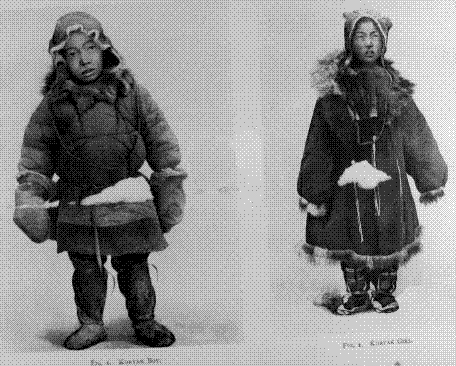
FIG.
1. KORYAK BOY.
FIG.2. KORYAK GIRL.,
The
Koryak.
603
JOCHELSON,
THE KORYAK
front
and behind
the rounded
ends of the coat dangle like
an apron and
a tail.
The flap
behind is longer than the
one in front. Among
most Eskimo, only
the men
wear short
coats cut
evenly all round.
But Nelson states that "from
the Yukon
mouth northward
to Point Barrow, the frocks of the men are
cut a
trifle longer behind than in
front."1
This calls to
mind the tail of the
coat of the tribes of northeastern Siberia.
In describing the dress of the Iglulimiut,
Parry2 says that
"the men
have also
a tail in the hind part of their
jacket," but smaller
than with women. According to Boas,3 coats with short
tails behind
are also
worn by
the Cumberland Sound
Eskimo. The reindeer-skin
coat of men of the Hudson
Bay Eskimo has a tail behind.4
It is
quite possible that this cut of the back of the coat of the tribes mentioned has
a
common origin.
So far as is known to me, however, the
Chukchee have no
tails on their coats, and the illustrations given by Bogoras show no such tails.
Excepting
the funeral coats, the Koryak nowadays cut all their coats
evenly
all round, even those used in dancing
and those worn by shamans.
Ornaments,
Hair-Dressing, and Tattooing. I shall speak later on of
the
ornamentation of dress.5 Here I shall only say a few words on personal
adornment.
In Part I (pp. 45, 46) I have already spoken of charm bracelets,
necklaces,
pendants for the hair, and the tattooing of the face and other
parts
of the body, all of which play the
part of "protectors."
These charmed
| objects differ nearly always
from ordinary
ornaments,
which have no connection
with magic in their lack of
beauty or symmetry. Thus straps made
of skin and
hair serve as amulets, which
are worn on the arms, feet,
and neck. The brass and
beaded bracelets and ear-
rings6 are much better
executed than the corre- sponding charms.
Hair- |
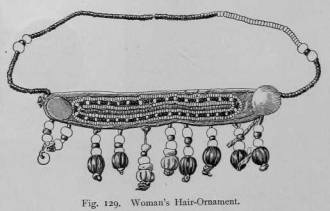
|
ornaments
worn by women (Fig. 129) may be readily distinguished by their beauty,
from the beads, straps, or tufts of reindeer, hare, or wolf hair, which
are
braided in with the hair of the head as charms against headache. Nearly
all
Koryak women wear the head-dress shown in Fig. 129
(see also Plate XXXVI),
which
consists of a beaded string with two large metal buttons at the ends,
and
a leather strap with pendants behind. Sometimes the back part of the
string
consists of a metal chain without leather foundation.
 1
Nelson, 34.
2 Parry, II, p. 495.
3 Boas, Baffin-Land Eskimo, p. 50.
1
Nelson, 34.
2 Parry, II, p. 495.
3 Boas, Baffin-Land Eskimo, p. 50.
4
Turner,
Fig. 51, p. 211. 5 See Chapter XI.
6 See Chapter X.
604
JOCHELSON, THE KORYAK.
The
Koryak women part the hair in the middle from the forehead down
to
the neck,
and braid
it behind
in two braids, so that
each braid begins
quite
close to the ear. The
back of the head is thus left free for the orna-
mented
leather strip, which extends nearly from one ear to the other.
This
style
of dressing the hair
is found
also among the women of the
Eskimo, Chukchee,
and the
tundra Yukaghir. Even nowadays stone
pendants are
often
attached to the ends of the braids.1 At present the ends of the braids
are
usually tied
with a
thong or
sinew-thread on which
beads are strung.
The
braids tied in this way rest
on the chest or back, oftener on the chest.
The
men cut or shave the hair with a sharp knife in the middle of the
head,
forming a round tonsure like that of a Catholic priest, leaving all around
a
thick ring of short hair; so that the forehead is free, and the hair is removed
from the nape of
the neck and the region about and under the ears.
The
ring
of hair is often supported by a small thong. The Koryak tie their hair
with
this thong when
fighting, running
races, tending the flock, or working.
Tattooing
for the sake of ornament has nearly gone out of use. I have
spoken
before of tattooing
as a protective device.2
Ornamental tattooing is
practised
by women
only, but
I have
seen very
few tattooed women; all
were
married. Two
of them were childless, so
that the tattooing may have
been done as a cure
for barrenness. That in
former times tattooing among
women was widespread,
may be
concluded from several myths
Thus it is
related 3
how River-Man,
on turning into a woman, had his face tattooed to
please Illa'. Neither
Steller nor Krasheninnikoff mentions that the Kamchadal
practised tattooing; both
state 4 that
the Kamchadal painted
their faces red
and white. Ornamental tattooing is called by the Koryak l๕-kele;
i.e.,
"paint-
ing
of the face."
Perhaps this
appellation applies
as well
to painting the
face with colors, a custom no longer met
with. Allusions to
this custom are
found in mythology: for instance, it is
told that Big-Raven's elder son painted
his
own belly.6 Judging
from Nordquist's and Borgoras's
descriptions, Chuk-
chee tattooing is
more complex than that
of the Koryak.
The tattooing of
Koryak women, which I
had occasion to see, consisted of two or three hori-
zontal lines over the nose, or of two
or three equidistant curves on the chin
and cheeks. The Koryak, and the other tribes of eastern
Siberia that practise
tattooing, do not
apply the
designs by
pricking, but by passing under the
skin a needle
and thread
which is
coated with
coal mixed
with grease.
Hence the Gishiga
Russians call
the Koryak
tattooing "face-embroidery."
I
learned from
one Koryak that in olden times the method
of pricking and
rubbing greasy black paint into the
holes was also practised.
Snow-Goggles
Snow-Shoes, Staffs,
and Ice-Creepers.
Like all other Arctic
tribes, the
Koryak use
snow-goggles to
protect the
eyes from
the
1 See
Fig. 138, p. 610.
2
See
Part I, p. 46.
3 Ibid., p. 304.
4 Steller, p. 300; Krasheninnikoff, II, p.
68.
5
See Part I, pp.
166, 177.
605
JOCHELSON,
THE KORYAK
.
dazzling
light reflected
in spring
by the snow-fields.
The snow-goggles are
made
of birch-bark or of wood, with a slit for the eyes.1
In spring, protection of
the eyes is of particular importance to herdsmen, who are constantly in
the
open
air, and
to drivers, who
undertake to carry merchandise on dog-sledges.
Snow-shoes are
of two
kinds. One
kind are
short, and
are called
"crow-feet"
el-yegit).2
They consist of a willow frame plaited with a thong.
Herdsmen and hunters wear these
snow-shoes for walking over uneven around
and hard snow.
The other kind are long, and
are called ti-yegit.3
They are
made of a
thinly planed
aspen board,
with pointed
ends and
tip turned
upwards,
and are lined
underneath with the skin from
reindeer-legs, the hair
running backward.
These snow-shoes are suitable for level regions, and give a
good support on soft snow,
thanks to their light weight and large surface.When "crow-feet"
snow-shoes are used,
the feet
are frequently lifted as in
walking, while on long snow-shoes gliding alone is resorted to.
The Eskimo
who, when hunting
seal in winter, have to cross rough and hummocky
ice, employ snow-shoes similar
to the Koryak "crow-feet;"
4 while the long snow-shoes are used
more by
hunters like
the Tungus
or Yukaghir, who hunt
wild
animals in the forests or
river-valleys covered with deep and soft snow.
The
Koryak, as
a rule,
do not make the long
snow-shoes themselves,
|
but purchase them from the Tungus.
The
flesh side of the skin is fastened with
fish-glue under the wooden snow-
shoes.
The edges of the skin are turned
over to the upper side.
For
smooth and slippery ice,
the
Koryak tie iron creepers under
the
soles of their shoes (Fig. 130).
In
ancient times ice-creepers were
made
of hard wood or bone.
I
rarely saw snow-staffs like
those
of the Chukchee and Eskimo,
with
attached ring.
The Koryak use more often ordinary willow rods, such as are
employed in their walks from
village
to village, from camp to camp, or in foot-races (see Plate XXXVIII, Fig. 1).
|
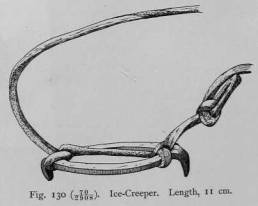
|
Yokes and Carrying-Straps.
For carrying loads when going afoot,
Koryak
men use a wooden le'tel. It is usually made of alder or of willow, and
consists of a flat stick about 50 cm. long, planed, and somewhat bent so as
to fit
the chest
(Fig. 131),
with notches at both
ends for attaching the
1
See Bogoras, The Chukchee,
Vol. VII of this series, Fig. 192, a, b, p. 260.
2
Ibid.,
Fig. 193, b, p. 261.
3
Ibid.,
Fig. 193, a, p. 261.
4 See
Nelson, pp. 212-214; Boas, Baffin-Land Eskimo, pp. 40, 41.
606
JOCHELSON, THE KORYAK.
loops of straps that are tied to the bag or other
burden (Plate xxxv, Fig. 1).
In
carrying burdens, the yoke or cross-bar is placed over the chest, the straps
rest
on the fore arms, while the load rests on the small of the back. This is
a
clumsy method of carrying burdens. The yoke presses against the chest, the
straps hinder the motions of the arms, and the burden lies too low on
the
back. To prevent the yoke from slipping down in walking, it is fastened by
means of a thong to the neck or coat-colla.
While the method
used by the men, of carrying loads by means of chest-yokes,
is found also among the Eskimo,1 the method employed by the
Koryak

Fig.
131. Man's Chest- Yoke. Length, 53 cm.
women is met with among many Indian tribes.2
The carrying-strap is depicted
on
codices and monuments of ancient Mexico.3 It is in use among the Ainu.
Among the ancient Kamchadal, only the women used the head-band,
while
the men used the breast-yoke like the Koryak.4 The Koryak women put
burdens, and also their children, into grass, nettle, or skin bags, which they
hold on the back, and carry them by means of a head-band passing across
the forehead. Plate XXXVI shows how women carry children on their
backs,
in a bag or without one, by means of head-bands. The head-band or
carrying-strap is made of
t thong-seal hide.
Fig. 132
shows the strap

stretched out. The small sticks in the middle are
inserted to stretch the skin
and
make it thinner. The ends of the strap are cut out and provided with
slits
through which to pass the straps of bags and of wooden or skin buckets, for
tying (see Plate xxxv, Fig.
2; and Plate XXXVI; also Fig.
160, a).
1
See Nelson, p. 211; and Mason,
The Human Beast of Burden, Fig. 2, p. 256.
2
See
Mason, The Human Beast of Burden, pp. 262, 263, 265, 268, 273, 277, 282.
3
See
Morse, Was Middle America peopled from Asia? (Popular Science Monthly, November,
1898, p. 5).
4
See
Krasheninnikoff, II, p. 24.
Jesup North Pacific Expedition, Vol. VI.
Plate XXXV.
The
Koryak.
Jesup
North Pacific Expedition, Vol. VI.
Plate XXXVI.
|
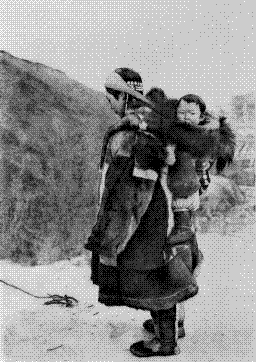
|
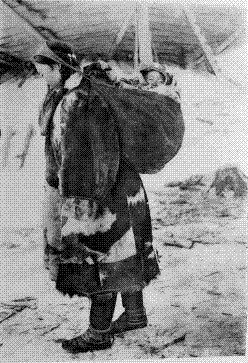
|
|
WOMEN CARRYING CHILDREN. |
The
Koryak.
607
JOCHELSON,
THE KORYAK.
Bags
for keeping Clothing. The Koryak keep their reserve clothing
in
bags made of the skins of ringed-seals, of spotted seals, or of ribbon- seals.
The skins are dressed on the flesh side, and the hair is left on. The
bags are made with the hair side out, and, like those of the Eskimo are
of two shapes, wide bags with a top opening, which is tied with thongs;
and
elongated bags, resembling a seal in shape, or made of an entire seal- skin, the flippers of which are sewed up. The openings of bags of this kind
are
slit across the chest and
laced up.1 The Maritime Koryak keep articles
|
not in use, and spare clothing, in such bags,
in
the houses or in storehouses. In the houses these
bags, with their contents, serve as
pillows. In winter, bags containing summer
clothing are kept in the storehouses; and
in summer the winter clothing is kept inthe same way. Funeral clothing not
fully finished is also kept in
storehouses.
Belts.
Women very rarely wear a
belt.
Embroidered carrying-straps2 belong to the
funeral clothing of women. The belt, however,
forms, part of the funeral dress of
men.3
This points to the fact that the belt
has been used by male Koryak for a long
time.
The Koryak gird up their house-coats
and
their short travelling-coats with their
belts.
The long fur travelling-coats, or the
overcoats
of leather or imported cloth, are
worn
without belts (see Plate XXXII, Fig.
I).
|
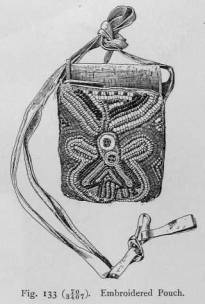
|
The
belt consists of a dressed strap of thong-seal skin, two or three fingers
wide,
with a large iron buckle.4 In ancient times, buckles were made of
ivory, and these may be seen even now. On the belt hangs a small belt-
knife
in a sheath, a case embroidered with glass beads containing a birch- bark tobacco-box, and often iron tweezers for pulling out hair (Fig. 133).
These
tweezers seem to me to have been adopted from the Tungus. Among
the
Maritime Koryak, belts are frequently embroidered with glass beads
(see
Fig. 202).
1
See illustrations in Bogoras,
The Chukchee, Vol. VII of this series, p. 192; and Nelson, p. 44.
2 See
Part I, Fig. 54, p. 109.
3 Ibid., Fig. 46, p. 106.
4 See Fig. 205.
77JESUP NORTH PACIFIC
EXPED., VOL.
VI, PART
2.


















